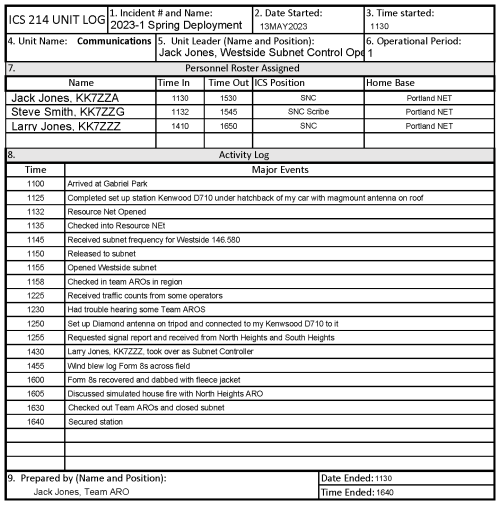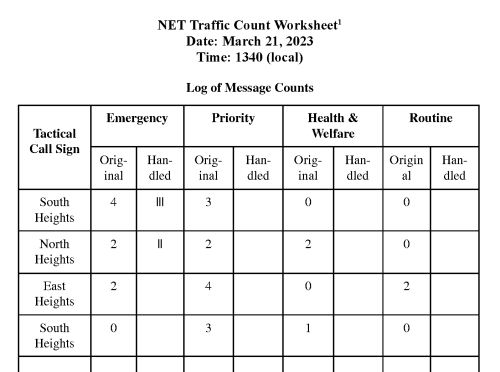Logging Procedures for Subnet Control Operators: Difference between revisions
BruceSchafer (talk | contribs) m (Took out extra space) |
BruceSchafer (talk | contribs) m (→Instructions for using the Traffic Count Worksheet: added comma) |
||
| (One intermediate revision by the same user not shown) | |||
| Line 67: | Line 67: | ||
=== Instructions for using the [https://docs.google.com/document/d/1FsFca0Yq1xIHZlihSXuZG-Fo5M-C8MzAfMyrGgdugH0/edit?usp=sharing Traffic Count Worksheet] === | === Instructions for using the [https://docs.google.com/document/d/1FsFca0Yq1xIHZlihSXuZG-Fo5M-C8MzAfMyrGgdugH0/edit?usp=sharing Traffic Count Worksheet] === | ||
* Each time reports available traffic use a new row to record the number of messages available at each precedence level. | * Each time a station reports available traffic, use a new row to record the number of messages available at each precedence level. | ||
* Each time you handle a message for that station, use a tally mark to indicate an increase in the number messages handled at the message’s precedence level. For instance, if one Priority message was previously handled for a station and you just handled a second one, the tally in the Handled column for Priority messages would change from “l” to “ll”. See the [[wikipedia:Tally_marks|Wikipedia article on Tally Marks]] for a discussion of tally marks. | * Each time you handle a message for that station, use a tally mark to indicate an increase in the number messages handled at the message’s precedence level. For instance, if one Priority message was previously handled for a station and you just handled a second one, the tally in the Handled column for Priority messages would change from “l” to “ll”. See the [[wikipedia:Tally_marks|Wikipedia article on Tally Marks]] for a discussion of tally marks. | ||
* If a station provides new counts of available traffic, start a new row and draw a line through the row that is now out of date. | * If a station provides new counts of available traffic, start a new row and draw a line through the row that is now out of date. | ||
Latest revision as of 16:50, 5 January 2024
The primary purpose for logging is to keep track of the activities of your station to allow you to operate more efficiently and accurately. A secondary purpose is to record information that may be used later to identify opportunities for improving procedures. In some cases, logs may be gathered and compared in order to understand how messages moved from originating stations to their final destination by one or more “hops”. Similarly, logs can be used to understand how replies were routed during a deployment.
Because your role as a subnet controller (SNC) includes a variety of procedures, no one form efficiently covers everything you should log. I recommend you spread logging across the following four forms.
- ICS 214 – Unit Log
- NET Form 6 and the similar ICS 309 Communications Log
- NET Form 6 for logging transmission of NET Form 8 or other forms by voice.
- ICS Form 309 for Winlink traffic which can be generated by Winlink Express
- Stations Participating Log. This is an unofficial form that should help you capture information about the stations participating in your subnet more efficiently than the above two forms.
- Traffic Count Worksheet. This unofficial form should help you keep track of counts of the traffic that the stations in your region have ready to transmit as well as traffic that you have already handled.
Note: For some short exercises you may not need all four forms. For instance, if you are serving as an SNC during an exercise that does not involve formal traffic you would not need to use Form 6 or a Traffic Count Worksheet.
Background
The ICS 214 Unit Log form is designed to record a roster of those involved in a particular unit and the activities of those people. The form’s header provides space for recording the incident name, date and time, leadership and operational period. Below the header are rows for recording a roster of those associated with a particular unit, in this case a communications unit. The lower part of the form is for recording the activities of the unit. This makes it useful for providing information about what happened and when – both for those who participated in those activities and those who arrive later. In addition, the information is useful for those interested in reviewing the activities of the unit and looking for opportunities for improving readiness and efficiency for similar future activities.
The NET Form 6 is based on the ICS 309 Communication Log form which is intended primarily for logging formal traffic - messages on forms. Limiting its use to such traffic should provide two benefits:
- The station’s operator should be able to more easily find records of forms previously transmitted, especially when a reply to such a form is about to be received.
- Those reviewing the logs later are more likely to have a clear picture of what messages were sent and received by the station.
The Stations Participating Log is an unofficial form designed to complement the two forms discussed above to help keep track of the stations that communication unit is in contact with as well as information like the readability of the radio communications with those stations. As it is not an official ICS form, it can be customized to the particular situation. In a pinch, use scratch paper instead. Using this form instead of recording check-ins on Form 6 or 214 will use less space and keep the information about each station together for easy reference.
The Traffic Count Worksheet is an experimental form for tracking counts of available formal messages as well as counts of messages handled so far. Feel free to customize it to meet your needs. The goal is to handle traffic based on precedence and give all stations in your region a chance to pass traffic that is equal to the precedence being passed by other stations. The worksheet should help you handle the available traffic by relative precedence and keep track of available traffic that you have not yet handled.
Instructions for using an ICS Form 214
- Each NET SNC should use ICS Form 214 to record the activities of their station. In other situations like a radio trailer or radio room, multiple stations and operators at the same location are all part of the same Communications Unit and would share a single ICS Form 214. Similarly, multiple operators working together at a remote site like an evacuation center would share a Form 214..
- Log your name and the date and time your station’s activation at the top.
- Also record your Name and Time In in the roster section. Do the same for any other operators or scribes serving with you.
- Record “ICS Position” as “Amateur Radio Operator” or "Scribe" or an abbreviation like “ARO” or "ARO Scribe".
- Record “Home Base” as “Portland NET”.
- When someone goes off during, record the time in “Time Out”
- If the incident command declares a new operational period, close the 214 and open a new one.
- When a station is closed or a new operational period starts, log the closing as the last item in Major Events.
- See ICS 214 Unit Log Instructions for additional details.
- See the following sample ICS 214.
Overview of using NET Form 6 (ICS 309) Communication Log
- Use NET Form 6 / ICS 309 for formal traffic only, not activities. One Form 6 should be used by each operator.
- Subnet controllers should record most activities on an ICS 214 rather than the NET Form 6 or ICS 309 with the following exceptions:
- Check-ins, readability, etc. should go on the Stations Participating Form or scratch paper.
- Message counts should go on a Traffic Count Worksheet or scratch paper.
- Use Winlink Express to generate an ICS 309 PDF for any Winlink traffic.
Instructions for Using a NET Form 6 (ICS 309) for Logging NET Form 8s or ICS Form 213s
- When a NET Form 8 is being logged, the right-hand field should start with the tactical call sign of the originating station, which may be the same as the team name.
- The originating station is followed by the date and time from the fields on the Form 8, followed by the Subject field from the Form 8.
- The Subject of a Form 8 should begin with message precedence, which should be copied into the right-hand field with the rest of the subject.
- For replies, the word “Reply” should be first followed by the information in the same column for the original message.
- FCC call signs should not be used in the From and To fields of NET Form 6 (ICS 309) , Instead use tactical call signs as illustrated below.
- In the example above the transmission of the messages that originated from North Heights and South Heights to ECC and the receipt of traffic from ECC are not shown here because they were transmitted via Winlink which can generate a separate log.
Instructions for using Stations Participating Form
- Each time a station checks in, record the time, the station’s tactical call sign and the operator’s FCC call sign.
- If the operator is representing a team at a staging area, record the name of the team.
- Also record the station’s readability. See Readability and Signal Strength.
- When the station checks out, record that time in the corresponding column.
- Feel free to customize this form to suit your needs. To provide room for more columns, you may want to change the orientation of the page from portrait to landscape.
Instructions for using the Traffic Count Worksheet
- Each time a station reports available traffic, use a new row to record the number of messages available at each precedence level.
- Each time you handle a message for that station, use a tally mark to indicate an increase in the number messages handled at the message’s precedence level. For instance, if one Priority message was previously handled for a station and you just handled a second one, the tally in the Handled column for Priority messages would change from “l” to “ll”. See the Wikipedia article on Tally Marks for a discussion of tally marks.
- If a station provides new counts of available traffic, start a new row and draw a line through the row that is now out of date.
- Start a new Worksheet for each shift or when worksheet has become obsolete.
- See the following sample worksheet.



